

© Shipping Wonders of the World 2012-

Norway to New Zealand in a Cutter
Accompanied by his wife and later by his young son and a dog, Erling Tambs sailed a 40-
GREAT VOYAGES IN LITTLE SHIPS -
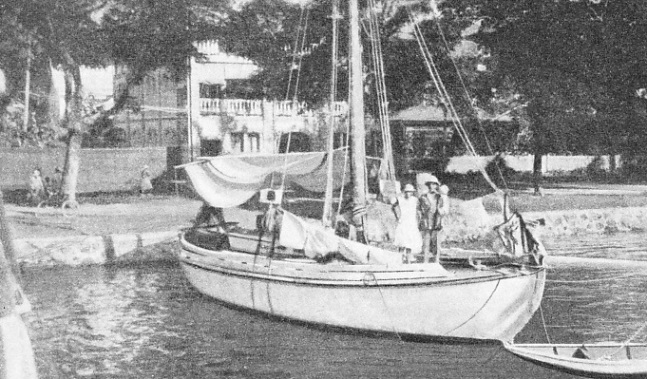
IN PAPEETE HARBOUR, Tahiti, the Teddy was moored stern-
OF all ocean voyages in small craft that of Erling Tambs from Norway to New Zealand is the most romantic. Tambs began his adventure as a honeymoon trip with his bride. The family had increased by two children and a dog by the time they swam ashore from the wreck of the yacht in New Zealand. Several married couples have made ocean passages, but in different circumstances from that of this Norwegian who, among other things, writes poetry.
This poetic streak is the keynote to Tambs’s character, and what in an ordinary man would be recklessness is just contempt for materialism in Tambs. Something more than sheer poetic frenzy, however, is required to take a small yacht more than half-
Tambs’s methods were more those of a seaman than a navigator, and have shocked orthodox yachtsmen. Despite this he sailed his yacht a long way by dead reckoning, and reached the places he wanted to visit, proving that a seaman with a sense of direction can equal the feats of the men who went all over the world in the old days before the sextant and the chronometer were invented. The great charm of his story, The Cruise of the “Teddy”, is its frankness. Many men prefer to omit their mistakes when they write about themselves, but Tambs makes no excuses, and is his natural, optimistic self.
His 40-
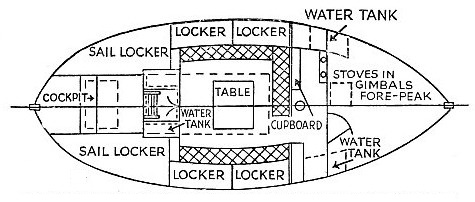
THE CABIN OF THE TEDDY measured about 9 feet by 9 feet and had two built-
Having spent eight years at sea, and having been trained in square-
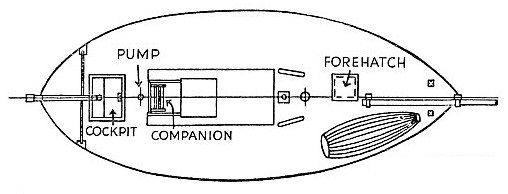 THE DECK PLAN OF TAMBS’S CUTTER, the Teddy. The cutter had an overall length of 40 feet and she carried a pram dinghy which had been specially built for Tambs at Arendal, Norway. The Teddy had been designed by Colin Archer, builder of Nansen’s polar expedition ship the Fram.
THE DECK PLAN OF TAMBS’S CUTTER, the Teddy. The cutter had an overall length of 40 feet and she carried a pram dinghy which had been specially built for Tambs at Arendal, Norway. The Teddy had been designed by Colin Archer, builder of Nansen’s polar expedition ship the Fram.
They sailed from Oslo, called at Larvik and then at Arendal, where Tambs collected a pram dinghy which had been built for him. Here he had trouble with the officials. They considered that the Teddy was not fitted for a long voyage as Tambs lacked certain navigational instruments and was not a navigator. Tambs pointed out that there was no law to prevent his sailing and he left. He had an old compass which swung badly in rough weather and made steering difficult. There were few charts, and no sextant, chronometer or nautical tables. The water tanks held 330 gallons, an ample supply. Two Primus stoves were installed in the galley in the forecastle, and the cabin was tidy and cheerful.
The first passage, across the North Sea and to Havre, took about sixteen days. The Teddy encountered rough weather on the first night out, and this weather continued all the way. The husband reefed while the wife steered.
The North Sea chart that Tambs had was so old that he could not recognize the lights of the Dutch coast by the particulars given on the chart. He stood close to the shore in the hope of seeing a lightship and reading the name on her side. He sailed so close to shore that he even began to look for a signboard. While he was thus engaged and the vessel was in shoal water a storm came onshore.
Every time the Teddy tried to turn her head to sea a breaker knocked her back. They thought they were doomed, but the next time Tambs put the helm down the yacht answered it, the mainsail filled and the yacht headed for deep water and safety, where Tambs was able to reef and heave-
They had two narrow escapes before reaching Havre. Tambs went so close to one lightship that the Teddy nearly rammed one of her anchor buoys. In the English Channel while Tambs was cooking a special Sunday breakfast, he heard a call from his wife at the helm. He dashed on deck and saw that a steamer, instead of giving way to the Teddy, in accordance with the rule of the road, had cut across her bows.
Tambs put the yacht into the wind and the steamer just cleared her, but the wash upset the breakfast and the stove on the galley floor, and the meal was spoiled. He shook his fist at the steamer, but the skipper on the bridge mistook the gesture and waved a glad and cheerful response.
If he had been so minded Tambs could have ended the voyage at Havre with a handsome profit, as he was offered a price for the Teddy which was three times what she had cost him, but he refused to sell.
In the Bay of Biscay the voyage nearly ended in a total loss. The Teddy was sailing under reduced canvas at night after a storm and Tambs was in the cabin, looking out at intervals. He heard a peculiar knocking which was repeated three times, so he went on deck. A barque, on the starboard tack, was swooping down on the Teddy, and he had just time to put the yacht on the other tack.
Defying Superstition
Despite the lack of instruments the steering was good. Tambs went off shore as soon as he had left Havre and the next land he sighted was Cape Ortegal, nine days later, on the north-
The south-
The next stage was round Cape Finisterre. This part of the coast, on the corner of the Bay of Biscay, is stormy. The Teddy had to punch against wind and current to reach the famous cape. Tambs intended to make for the harbour of Corcubion, but he had no chart and realized that he could not gain the anchorage before dark. Therefore he turned back, to Corme, and arrived with a squall. His anchor would not hold, and he brought up by luck, as he was able to throw a line to some men in an old steamer, and they made this fast to the vessel’s anchor chain.
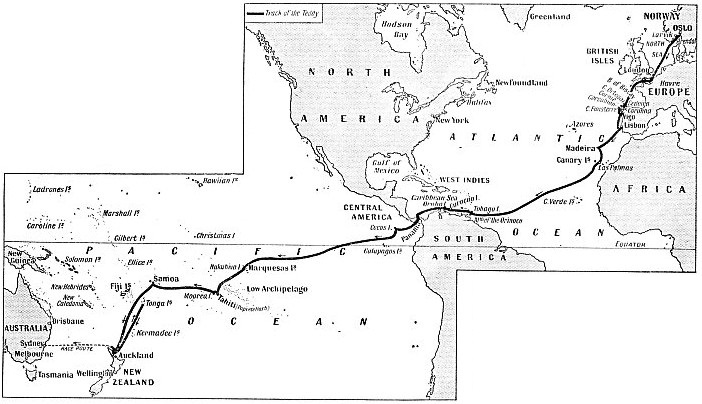
FROM NORWAY TO NEW ZEALAND. Tambs sailed in nearly two and a half years. He left Norway in August 1928 and arrived at Auckland on January 6, 1931. The passage across the North Sea and to Havre was squally and dangerous. Further bad weather delayed the Teddy before she left Europe for the Canary Islands, where Tambs’s son, Tony was born. Tambs bought a sextant at Lisbon before he sailed across the Atlantic and through to the Panama Canal. When the outward voyage was over, the Teddy took part in a race to Sydney and later cruised among the Tonga Islands.
Having sailed from Corme for Lisbon on a Friday Tambs argued about the folly of superstition with his wife, who believed it was unlucky to sail on that day. During the argument he allowed the boat to gybe, and his boom broke off. To repair this he put into Vigo, where a Norwegian steamer was lying. Tambs was given a dog born in the Norwegian ship, and named her “Spare Provisions”, although he usually called her Teddy. At first the dog, which was similar to an Alsatian, but of no known breed, was sea-
Tambs bought a second-
Some of the inhabitants of Las Palmas were critical of Tambs’s decision to sail with the baby, and when the trade wind increased in force the father had a period of doubt as to whether he was doing the right thing. Then the wind eased and his doubts fled. He took heart by reflecting on the fresh air and sunshine in which the baby would bask and become a true child of a great seafaring people.
Not having a chronometer, Tambs had to rely upon latitude by noon sight and his longitude was a matter of guess-
Instead of altering course to the north he turned south-
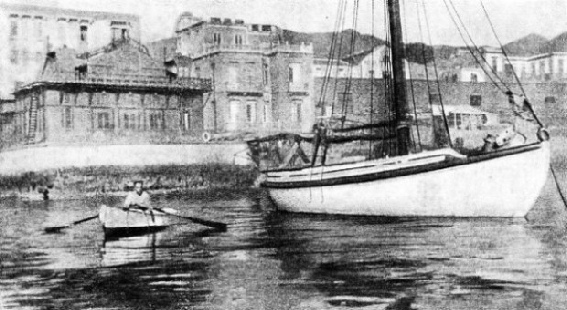
THE TEDDY AT SANTA CRUZ, the chief town in Tenerife, one of the Canary Islands, and renowned for its lack of rain. On her way from Funchal, Madeira, to Las Palmas, Grand Canary, the Teddy put in at Santa Cruz for more than a month. She arrived in the middle of the night, drifting into the harbour with slack sails.
During their stay the heat shrank the planks in the high topsides of the Teddy so much that she leaked badly when she sailed, and Tambs had to put in at another island, Oruba, with two feet of
water in the hold, and no cash to overhaul her. Tambs overcame the money trouble by giving a lecture. He spent nearly five months in the Panama Canal Zone.
For seven weeks the Teddy was berthed in a corner of the harbour on the Atlantic side. Tambs began to write a book and waited until someone would offer him a tow. Vessels are not allowed to sail through the canal, and the Teddy did not have an engine, nor could he spare the equivalent of £20 for a tow.
Finally, the Teddy was towed to Gatun Lock by an American yacht, where she was left in the lock chambers, and she sailed without a pilot to Gamboa. A launch towed her through the Gaillard Cut to Pedro Miguel, and she passed through these locks and those at Miraflores. A final tow took her to Balboa, where she stayed for some time. Tambs then sailed to Cocos Island, but not to make a serious search for the treasure which so many people have tried to find. He had an amazing escape from being marooned on the island. He left his wife and child in the Teddy and went ashore in the dinghy for some coco-
Tambs made a raft of saplings bound together with rope yarns from what was left of the painter. He embarked on the raft and began to pole towards the yacht, but he got into deep water where he could not reach the bottom, and the tide began to carry him past the yacht. He shouted, but no one heard at first. Then the dog heard, and awakened Mrs. Tambs. Dashing on deck as her husband was being swept by, she seized a fishing line and threw an end to him. He grabbed it and pulled the frail raft towards the yacht. Directly the saplings touched the yacht they broke away, but Tambs swung himself on board out of reach of the sharks. His first task was to sail after the dinghy and return with it, then he gave the dog her reward, a sumptuous meal. Provisions were scanty when the Teddy sailed from Cocos Island and Tambs intended to call on the few Norwegian settlers in the Galapagos Islands. The wind was adverse, however, and he decided not to waste time trying to reach the Galapagos, where he was not sure of getting supplies, so he altered course for the Marquesas, about 3,500 miles away. The Teddy reached Nukuhiva in forty-
When the Teddy sailed for Tahiti, Tambs did not stop in the Low Archipelago. He was becalmed in a current among these islands and the Teddy was so shaken about by the disturbed water that the forestay broke and the mast damaged the collar where it passed through the deck. Squally weather followed and the yacht shipped a good deal of water through the hole round the mast. Tambs was glad when the yacht was moored stern-
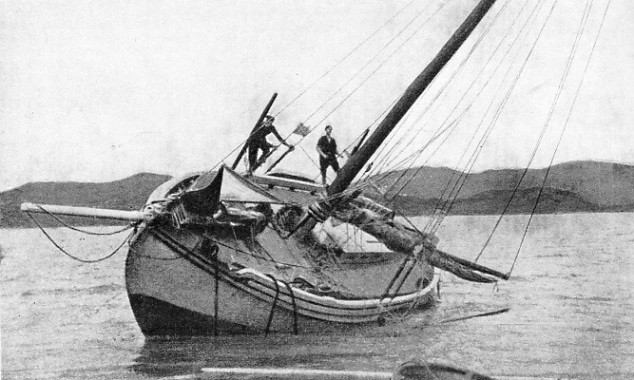
IN THE BAY OF ISLANDS, on the north-
So badly did the soft wood of the Teddy shrink while she was lying in the Tahitian sun that she was nearly lost when Tambs left the harbour. Water poured in through the gaping seams. The pump broke, but she managed to run before the strong wind into a harbour in Moorea, opposite Tahiti, with the water up to the level of the top of the cabin table.
The Tambs family had a wonderful time in the islands and all the way to Samoa, but after the yacht had left Samoa for New Zealand, all became ill. The mother and the baby had a slight bout of influenza. Tambs poisoned his right hand, and the influenza caused complications. He grew so ill that he feared he would die.
For nearly three weeks the Teddy sailed herself across the Pacific, while Mrs. Tambs nursed her sick husband and tended her little son. On Christmas Eve Mrs. Tambs cried out that the yacht was surrounded by reefs. Having struggled out of his bunk, Tambs fell against the companion, his arm, swollen by the poison, bearing the full force of the blow. Strangely enough, this marked the turn in his condition. The reefs proved to be porpoises, and after this great relief Tambs began to mend.
Race to Australia
In his usual cheerful way Tambs sailed into Auckland Harbour, New Zealand, without mishap, and without either charts or a pilot book. The family stayed with a relative in New Zealand.
While Tambs was fitting out to resume his voyage an Australian yacht arrived, and the owner issued an open challenge for a race to Australia. At first no one took up the challenge, so Tambs offered to sail with a crew of New Zealanders, and then a New Zealand yacht entered as third competitor. Tambs left his wife and son in New Zealand and sailed to Sydney. He won the race by his handicap allowance.
On the way back to Auckland Tambs accepted a tow during a calm, but the tow-
For some time the Tambs family lived ashore. Then they resumed their life afloat. The Teddy cruised among the Tongas and returned to New Zealand. After further cruises she was fitted out and sailed out of Auckland, bound for Brisbane, Australia, rather more than a year after her arrival.
Becalmed off the New Zealand coast, the Teddy was gripped by a current and carried towards the rocks. Tambs had securely lashed the anchor in the forepeak and stowed the chain in the stern. He seized a sweep to try to get clear of the rocks, but the current had the yacht in its power. Tambs struggled with such frantic efforts that the sweep broke.
Then a wave smashed the vessel against the rocks. Mrs. Tambs had lowered the sails, and the main boom swung across the deck as if it were a giant flail threatening death. Tambs dashed for Tony, who was tied by his harness rope, and freed him. Tambs jumped into the surf with the boy in his arms. He placed Tony on a ledge of rock above the surf and then returned to the yacht. Then he took his second child, the girl, from Mrs. Tambs.
His wife slipped and fell into the surf between the yacht and the rocks. Tambs, with the little girl to save, had to watch his wife struggling for her life for a few moments until he could bear it no longer. He dashed into the sea with the baby and handed the child to Tony, and then turned to save his wife.
To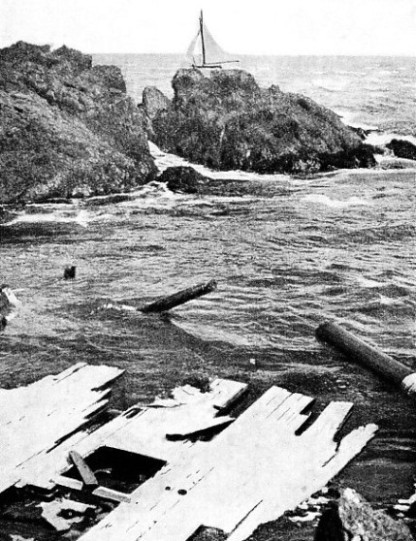 his joy he saw that she had swum clear of the surf and that a motor-
his joy he saw that she had swum clear of the surf and that a motor-
THE LAST OF THE TEDDY. On a voyage to Brisbane, Australia, the Teddy was becalmed and gripped by a strong current which carried her against the rocks on Challenger Island, in Hauraki Gulf, New Zealand. Tambs, his wife, two children and dog escaped with their lives, but the Teddy was a total loss.
You can read more on
“Adventures of the Dream Ship”, “Supreme Feats of Navigation” and “Thames to Tahiti”
on this website.